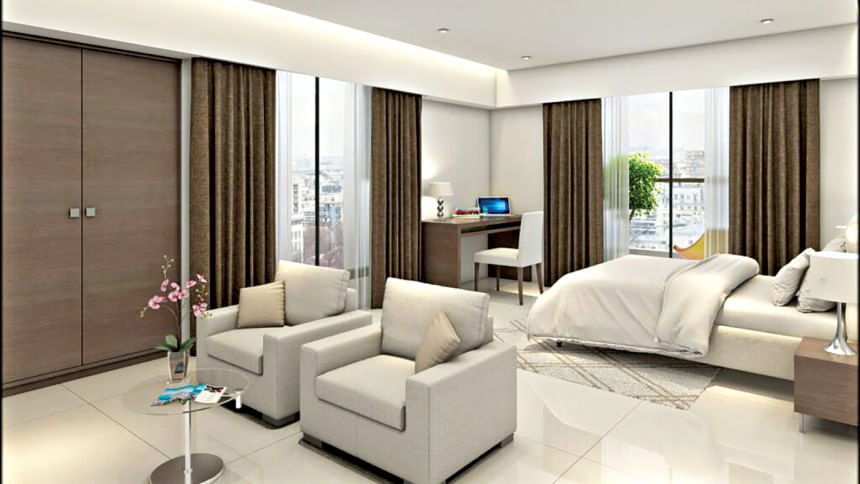Tiny Turns Trendy

The traditional dream of a sprawling family home is rapidly shifting in Bangladesh's fast-growing cities. Soaring property prices, limited land, and shrinking living spaces are rewriting the housing story. In this new chapter, one trend is quickly capturing the imagination of urban dwellers: the studio apartment. Compact, efficient, and stylish, these small flats are proving to be much more than a passing fad. They are a practical answer to the modern challenges of city life.
Studios go mainstream
What was once considered a niche idea is now firmly in the spotlight. Studio apartments often consist of a bedroom, living area, and kitchenette that come together in a single open-plan space. These are being embraced by single professionals, young couples, students, and even savvy property investors. For city residents juggling fast-paced lives, the blend of affordability, convenience, and contemporary design is hard to ignore. In Dhaka and Chattogram, the appeal of compact living is growing stronger every year.
Why small Is winning
The reasons behind this surge are clear. Relentless urbanisation has triggered population booms in Bangladesh's major cities, putting severe pressure on the housing market. With land scarce and real estate prices climbing beyond the reach of many, large apartments are increasingly unattainable for middle-class families and young professionals.
Here, studio apartments present an ingenious solution. Typically sized between 250 and 1,000 square feet, they are far more budget-friendly than larger flats. This affordability makes homeownership a realistic goal for first-time buyers and a low-maintenance lifestyle choice for those embracing minimalism.
For young couples just starting their careers, the appeal is straightforward: studios fit their budgets. Beyond the lower purchase price, utility costs are reduced too, making these homes financially sustainable in the long run.
Developers join the race
Real estate developers have been quick to recognise this shift in demand. Companies such as Rangs Properties, bti, and Concord are designing innovative studio projects in high-demand locations, including Gulshan, Banani, Bashundhara, and Uttara. These developments are not limited to bare-bones units. Many feature amenities that appeal to modern buyers, such as rooftop gardens, fitness centres, and round-the-clock security.
Pricing, of course, depends heavily on location. In Dhaka's most sought-after neighbourhoods, a studio apartment can range from BDT 30 lakh to 80 lakh. In more accessible areas such as Mirpur or Uttara, prices start from around BDT 20 lakh. In Chattogram, studios are even more affordable, often priced between BDT 12 lakh to 35 lakh.
Renters can't get enough
The popularity of studio apartments is not limited to buyers. The rental market is equally robust. In Dhaka, monthly rents typically range from BDT 10,000 to 40,000, depending on the area and facilities. This makes them an attractive choice for students seeking independence, expatriates on short-term assignments, or professionals relocating for work. The steady demand ensures that these compact homes rarely stay vacant for long.
Small spaces, big returns
From an investment perspective, studios are proving to be a smart bet. Rental yields for such units average 5–8% per year in Dhaka, higher than what larger apartments usually generate. Strong and consistent demand keeps rental income steady, and with growing urbanisation, resale values are also rising. Investors who enter the market early stand to gain significant returns as compact living becomes the norm.
Living large in less space
The move toward smaller homes is not merely a compromise; it is also about embracing efficiency and modern design. In Bangladesh's urban housing market, where affordability and practicality often outweigh luxury, studio apartments strike the right balance. For many, these compact units represent the first step on the property ladder. It is the dream of owning a home in the city without breaking the bank.
Experts predict this trend will only intensify. As cities continue to expand and the middle class grows, developers are expected to focus more on compact, smart homes. These will maximise space, integrate modern design features, and increasingly incorporate sustainable building practices to match global trends in urban living.
The future is compact
Bangladesh's studio apartment trend is not just about adapting to constraints; it is about embracing a new vision for city life. It reflects the changing aspirations of a younger generation that values mobility, affordability, and independence over size alone.
For a growing number of Bangladeshis, these small flats are more than a roof overhead—they are symbols of progress, modernity, and a practical lifestyle suited to today's urban reality. In the story of Bangladesh's housing future, one thing is clear: less is truly more.

 For all latest news, follow The Daily Star's Google News channel.
For all latest news, follow The Daily Star's Google News channel. 



Comments